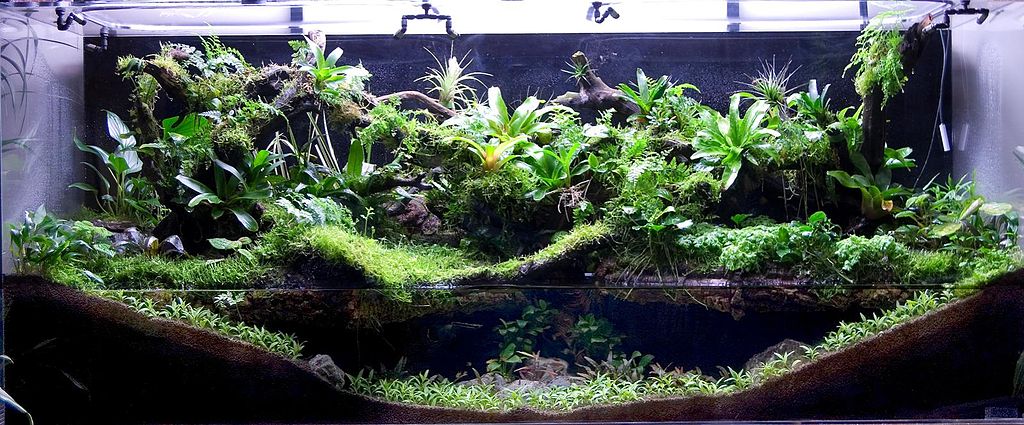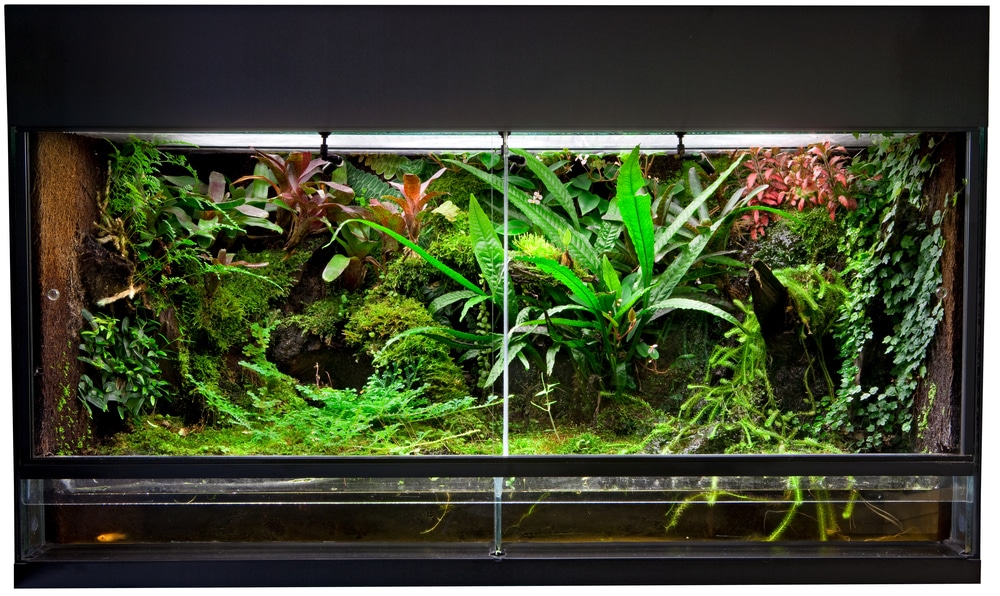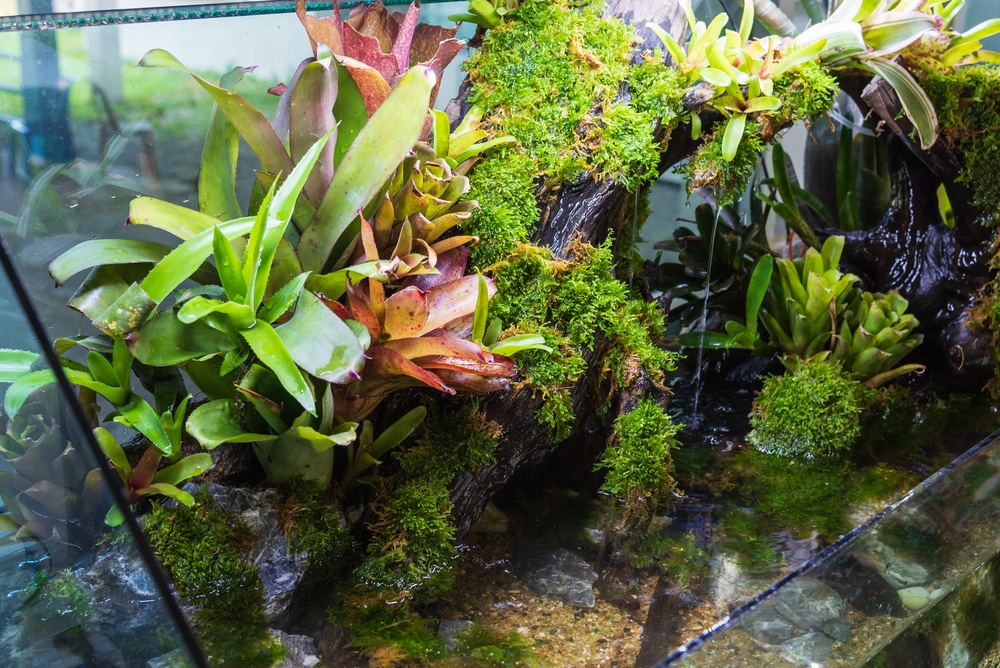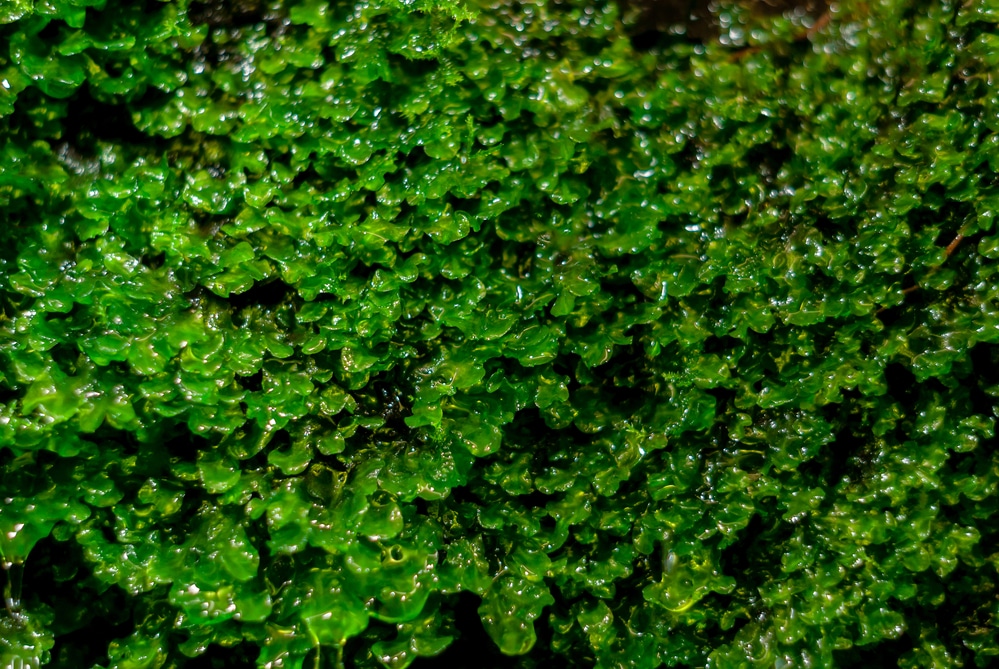Aquariums and Terrariums are well known. However, Paludariums are often new to hobbyists, even if we’ve probably seen one before.
While they take far more effort to plan, Paludariums are not necessarily more difficult than aquariums or terrariums – and they are as customizable as both Aquariums and Terrariums put together!
What is a Paludarium?

As you know, an Aquarium is a fully aquatic environment for fish and other underwater residents. A Terrarium is land-only and an enclosure meant mostly for reptiles and amphibians.
By combining water deep enough for fully aquatic animals with enough land for semi-aquatic to terrestrial critters to thrive, Paludariums fuse land and water within a single enclosure!
Paludariums are some of the most attractive Vivariums (living enclosure for animals) you can design.
They usually replicate natural riverbank features, giving them a chaotic yet pleasing aesthetic that makes each one a unique work of art.
Paludariums also multiply several fold the types of animals you can keep. Fish are a staple of the aquatic zone. However, you can also include frogs, salamanders, invertebrates and semi-aquatic reptiles.
Land dwellers include amphibians and reptiles, including snakes, turtles, and lizards.
Community Paludariums are especially challenging because you need to balance the needs of some very diverse groups.
While turtles and fish seem perfect for each other, many turtles are predatory and will find fish trapped in the Water Layer easy pickings.
Despite the challenges, a successful Paludarium creates a representation of nature that will captivate everyone who looks within!
Paludarium Layers

Key to designing a Paludarium is pre-planning how each section will come together. Paludariums are more complex in design compared to a typical aquarium but no more so than any other planted aquascape!
Water Layer
The Water Layer of a Paludarium is the first and most obvious section. Our aquarium or custom enclosure will only be partially full because we need a Land Layer to transition to.
The Water Layer has all of the needs of a standard aquarium, including filtration, heating, and water changes. Since the Water Layer is only a fraction of the normal volume of a full aquarium, you have far less work to do in this regard.
If you have a 75 gallon Paludarium with 15 gallons of water, you can use a 50W heater instead of a 300W version and a filtration unit appropriate for a 15 gallon aquarium, species depending.
Turtles, frogs, and many other Paludarium inhabitants create significantly more waste than most fish. And a smaller water volume means the Paludarium will foul much faster.
If you decide to go fish-only and have a light population, a small filtration unit, combined with nitrogenous waste uptake from plants, will be enough.
Land Layer
Most Paludariums seek to replicate a waterside environment, such as a river or stream bank. This means we want to give thought to not only the portions above water, but how the substrate leads to the land.
When designing the Land Layer, aesthetics and the needs of your plants and animals should be carefully balanced.
The transition zone is particularly important if you plan on adding air breathing amphibians or reptiles that need to be able to enter and leave the water with ease.
Driftwood, plants, rocks, and sloped substrate all help these animals navigate between water and land.
Custom fitted barriers can also help substrates sit securely against the Land Layer without losing form due to gravity over time (more on that later).
The height of your Land Layer will also affect whether you have a moist or dry zone. If keeping amphibians a moist zone is where they will tend to frequent.
Reptiles, even aquatic ones like turtles, should always have an area to bask and fully dry their skin. A dry zone can also be part of the Canopy Layer if keeping lizards and other climbing critters in a Paludarium.
Canopy Layer
The Canopy Layer is the section people tend to either ignore or go all-out when designing a Paludarium. Tall plants that send leaves into the air, rocks, and driftwood can all form portions of the Canopy.
The Canopy Layer will be inhabited exclusively by plants, reptiles, and amphibians. If you prefer a fish-only Paludarium you won’t place as much attention here save for aesthetic reasons.
If keeping climbing reptiles you’ll need to design the Canopy in such a way that a good basking spot is available. The higher air flow and humidity also makes this area important to Paludarium residents.

Some Paludariums (more accurately known as Ripariums) forgo the Land entirely and run straight from Water to Canopy! For example, a specimen driftwood piece can create the appearance of a tree twisting out of the water.
Among the “branches” of our tree and on a custom backdrop, epiphytic plants can be nurtured. Epiphytes don’t need to be rooted in sand, gravel, or another substrate. They attach directly to rocks, driftwood, and other hard surfaces.
That being said, the vast majority of Paludariums include enough habitable Land for plants and critters that need to leave the water.
Materials for Dividing Water, Land, and Air
As simple glass boxes, building layers of water, land, and canopy can be challenging.
Many Paludarium designers stick strictly to rocks, substrate, wood, and plants. But there are a few hardware store additions that can greatly expand your creative possibilities:
PVC Egg Crate
PVC Egg Crate is one of the most flexible building materials for a Paludarium. It doesn’t leach chemicals into the water and can be picked up at any hardware store or online.
Egg Crate can be shaped with a hacksaw or shears into islands, platforms, and equipment guards for pumps and filters.
When building shelves you’ll need to include a substrate for growing plants or providing a space for terrestrial animals. Given the size of the Egg Crate holes, you won’t be adding gravel to it directly.
Instead, you can add a section of appropriately cut plastic mesh to hold gravel or a soil plant substrate. Alternatively, you can use a dense substrate like peat moss.
Plants growing on an Egg Crate shelf can send roots right through the Egg Crate and down into the water column.
One problem with piling up sand or gravel is that it will eventually settle and disperse. Egg Crate with a mesh cover can also be placed vertically and glued to the aquarium glass to act as a retaining wall for built up sand or gravel.
Spray Foam
Spray Foam is earth in a can for a Paludarium. It can be added to rocks, applied to Egg Crate, or even onto the aquarium glass itself.
When appropriately colored, Spray Foam makes a fantastic rock-like background and can be shaped to hide pipes and other internal equipment.
Spray Foam can even be shaped into miniature pots for non-Epiphytes to grow along the walls of a Paludarium!
Its possibilities really are limited only by your imagination.
You’ll want specifically expanding insulation foam normally used for windows and doors. Great Stuff Spray Foam is the most popular brand used by Paludarium designers!
Once fully cured over the course of several days it is inert and non-toxic to animals and plants.
Keep in mind that while working with fresh Spray Foam, the fumes are dangerous and will tend to collect in the confines of the Paludarium.
Bending to reach an item and suddenly inhaling a load of fumes can cause unconsciousness so work in a well ventilated area.
Right out of the can, Spray Foam is not especially attractive. You should use black epoxy or colored 100% Silicone to hide the appearance while still having a flexible building material.
Either material can also be applied directly to the glass before adding Spray Foam in order to keep the Paludarium corners from showing the yellow foam when viewed at an angle.
Adding bits of sand, soil, or coconut fiber before the outer colored coating dries creates a natural aesthetic for your Spray Foam creations.
Paludarium Lighting
The prime consideration for most Paludarium lighting is how much and what kind of light your plants require. Fluorescent, compact fluorescent, and LED fixtures can all work so long as the light spectrum is ideal for your plants.
While full spectrum lights (5000-6700K) provide a balanced, natural look, plants actually need PAR (Photosynthetically Active Radiation), which is concentrated in the Blue and Red zones of the spectrum.
Plants with higher light requirements need PAR taken into account. But most moderate to low light Paludarium plants get by just fine on standard full spectrum lighting so long as you’re providing enough watts for the volume of your Paludarium.
Paludariums with a screen or open topped design can also use suspended metal halide lamps which create an intense point source light and a shimmer to the substrate from the water’s surface.
Lighting is further complicated if you include amphibians or reptiles. All reptiles and many amphibians need to bask in order to raise their core temperature.
Most Paludariums with basking creatures use a basking bulb that’s either hot and bright enough to reach the surface for non-climbers like turtles or placed directly above Canopy Layer branches for climbing frogs and lizards.
The exact bulb wattage depends on the distance from the basking zone to the bulb as well as the area covered. Fortunately, Zoo Med provides a wide array of incandescent basking bulbs.
Reptiles and amphibians also need UVB lighting to create Vitamin D3 and are at greater risk of osteoporosis without it.
Fusion lighting setups like Zoo Med’s Pal
udarium Uvb + Plant Growth Light Kit provide both a plant grow light and source of UV for your critters.
However, many of these animals will still need a separate basking bulb for heat (infrared light).
Paludarium Filtration
Canister filters are the best choice for most Paludariums. They are quiet, efficient, and the filtration media can be endlessly customized.
The outflow is also easier to set up with a line to direct water into the upper regions of the environment.
In a smaller Paludarium, submersible internal canister filters provide enough space for nitrifying bacteria to flourish.
Plant growth should also be taken into consideration because in mature Paludariums with a low animal population they can mostly or fully replace mechanical filtration.
The outflow of the filter is a very important aspect of the Paludarium because it works as a water pump as well. Well placed silicone hoses allow you to water plants in the canopy.
Splitting the hose into several smaller hoses or drilling holes into the main line can create an entire drip zone or curtain of water for the spray foam background.
Add some Java Moss and you have a “rock” wall with a trickle of water and greenery as if in a forest.
Best Paludarium Plants
Here are a few paludarium plants that we recommend:
Fully Aquatic Plants
Remember that the diminished water volume of a Paludarium limits the height of many aquatic plants you select.
Taller plants like Amazon Swords and Vallisneria will take on a cramped, busy growth pattern once they reach the water’s surface that may not be attractive to you.
Creeping plants as well as those with shorter maximum heights are often used to minimize time spent pruning. Your plant choices are as diverse as those of any regular aquarium.
However, light intensity can be a real problem if the Canopy Layer is crowded with large leaved terrestrial plants. Even if ample light is an issue, there are many Low Light Aquarium Plants that will do well in a crowded Paludarium!
Floating Aquatic Plants like Duckweed and Water Lettuce are options that add diversity and add to the swamp aesthetic.
They also aggressively uptake nutrients like nitrates from the water column, helping the ecosystem remain healthy. However, they also compound lighting issues for any aquatic plants beneath them.
Partially Submerged Plants
Many popular aquatic species such as Anubias actually grow in the transition zone in nature. They can grow both submerged or above water, making them perfect Paludarium plants.
Other popular aquarium store plants that grow well in the transition zone include Java Fern and African Water Fern.
Many house and garden plants also do well with submerged roots and emersed leaves. Golden Pothos (or Devil’s Ivy – Epipremnum aureum) is one of the most popular houseplants in the world. Golden Pothos are fast growing vines with attractively streaked, broad leaves for animals to perch on.
Hygrophila sp. are also easy to find and grow. Normally sold as purely aquatic plants, they will continue to shoot upwards once they break the water column.
Miramar Weed (Hygrophila pinnatifida) is my personal favorite because it not only grows under or out of the water but is also an epiphyte for maximum flexibility!
Dwarf Hygrophila and most of the other species also work well as emersed plants.
Terrestrial Plants

You’ll want to be looking out for epiphytes mostly. Many plants that thrive in high humidity environments and attach directly to substrate sinclude Bromeliads, Orchids, and Air Plants (Tillandsia sp.).
Air Plants have a round, spiky growth pattern few plants can replicate and even flower.
Moss are some of the most thematic Paludarium plants. They create a natural aesthetic that’s hard to beat and can hold and transport humidity throughout the environment.
Many are challenging due to varying light and moisture needs. Some are fully aquatic, others will grow partially submerged, and others still prefer fully terrestrial environments.
Java Moss (Taxiphyllum barbieri) is an epiphyte that’s normally grown submerged. However it can inhabit the Land and Canopy Zone so long as it has a constant spray of water and high humidity.
Club Moss (Selaginella emmeliana) prefers a soil or peat substrate and has a prehistoric appearance that’s hard to beat. Pillow Moss (Leucobryum sp.) are slow growing epiphytes that can be grown directly on wood or scattered across the Paludarium.
Moss are an entire world of attractive plants that can be used to coat nearly every surface of your Paludarium.
Cups of soil buried in the substrate of the Land Layer or hidden within foam backgrounds of a Canopy allow you include nearly any non-epiphyte as well.
Carnivorous plants often grow in swampy regions and are fascinating additions so long as you choose your animal inhabitants very carefully. Butterworts (Pinguicula sp.) grow in nutrient-poor soils and depend on their sticky leaves to trap tiny insects.
Wingless fruit flies are easy to culture and will also feed small frogs and fish.
Venus Flytraps (Dionaea muscipula) are iconic and thrive in the bog-like conditions of Paludariums. However, they should be placed in pots that can be removed as they require a winter dormancy period.
Special Notes on Epiphytes
As mentioned earlier, Epiphytes are plants that don’t need a root substrate and grow directly attached to a hard surface.
One thing to keep in mind is that the majority of Epiphytes will actually die if you try to root them.
The rhizome needs to be exposed for proper air/water circulation and will rot if covered.
Attaching an Epiphyte is a simple matter of using wire, string, or a rubber band and binding the plant to a hard surface. How long it takes the Epiphyte to bond depends on the growth rate of the plant.
Java Moss will be mostly secure within a week. Anubias, Air Plants, and other slow growers can take up to a month.
Avoid disturbing the plants during this process to ensure the fine hair-like structures used to attach aren’t disrupted.
Conclusion
Paludariums can be a lot to take in because the possibilities are endless. This also makes them incredibly fun and a study in both art and how natural ecosystems function.
Successfully keeping plants, fish, reptiles, and amphibians in a single enclosure is a Paludarium worthy of any zoo!


Wow great information for me and my family. I just bought a 125 gallon tank and we are going to turn it into a paludarium so wish us luck.